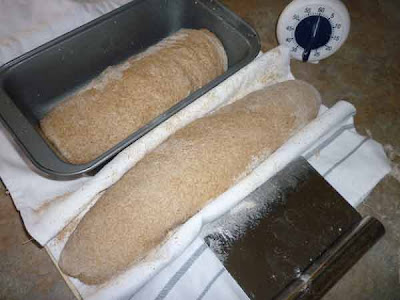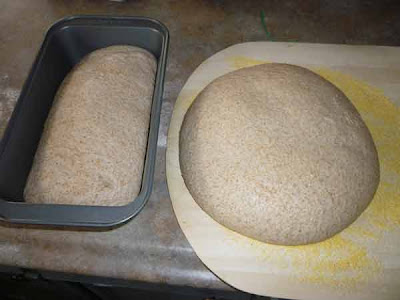I'd like to revisit that loaf for today's 'Everyday Bread', only I'm going to try something a bit different not only in the ingredients, but also in the way I mix it, and the way I fold it up. Kuhne's original loaf was just graham flour and water. I didn't have graham flour back then, so I tried rebuilding that 'unbolted flour', using all purpose flour, bran and germ.
The last time I made this loaf, I used a bit of yeast, and just mixed it all together into a single dough. This was the result. Pretty dense, right?
In today's version of the recipe I'm still rebuilding the flour, but in addition to those grain parts, in this recipe I will add yeast, and substitute milk for some of the hydration. And I'll take advantage of the fact that the grain parts are in different form to pre-ferment the bran and germ, and use the plain all purpose flour for the heavy work of lifting the dough in the way I put it together. The original idea of soaking the bran and germ comes from other members of the Freedom Gardens bread group where I originally tried making Kuhne's bread; since working through Reinhart's book, the idea of pre-fermenting parts of it begins to make much more sense to me.
The idea behind rebuilding the flour is to include everything that is in the original wheat, in the same percentage ratios (endosperm : bran : germ = 83 : 14.5 : 2.5), but to mix them up separately. Kuhne only added water, but I will also add yeast, and milk -- and why not some salt, while I'm at it? -- for this experiment.
To invent this recipe, the first thing I did was look at the entire ingredients (this picture was snapped before I thought of adding salt too).
Total Ingredients for 1 loaf:
644 g -- 4 1/8 cups all purpose flour
81 g --1 2/3 cups bran
8 g --1/8 cup wheat germ
213g --1 cup water
210g --7/8 cup milk
5 g --1 1/2 tsp yeast
4 g --1 tsp salt
?
1/2 tbsp honeyomit
1/2 tbsp butter
It makes sense to me to preferment and refrigerate the wheat germ and the milk, so I planned to mix those together. Originally I was going to simply divide the rest of the hydration between the flour and the bran, 50:50. But when I looked at all the ingredients set up in this way (see above), I grew dubious.
First, it didn't look like there was going to be enough water to mix up the all purpose flour. So, I thought I would be reserving a bit of the milk to help out. So I just added 1/3 cup of the bran and 1/4 cup of the milk at a time to see what I would end up with. Not only did the milk mix up the germ and all of the bran (see the picture with the mixing bowl with spoon, below), it was also able to incorporate a cup of the all purpose flour (see the picture with the mixing bowl without the spoon, below). So I just made one bigasoaker of all those ingredients.
Obviously I'm just making this up as I go along, And that is actually the fun part.
BigaSoaker:
8 g 1/8 c wheat germ
81 g 1 2/3 c bran
156 g 1 c all purpose flour
210 g 7/8 c milk
1 g 1/2 tsp yeast
Mix it thoroughly and refrigerate overnight
Dough:
488 g 3 1/8 c all purpose flour
253 g 1 c water + 3 1/2 tbsp
4 g 1 tsp yeast
4 g 1 tsp salt
When I looked at what remained of the ingredients, however, I was still worried that this wouldn't be enough hydration for the flour. In Reinhart's Bread Baker's Apprentice, he says the classic French dough has 100% flour, 60%water, 2% each of salt and yeast. To get the rise of the dough that I want, I should be in this ballpark, so how much hydration should I require? 60% of 488 g is 293 g of water. I would have to add 53 g to the single cup that is already there -- which works out to be 0.2208 c (pretty darn close to 3 1/2 tbsp).
So, to the above hydration, I added 3 1/2 tbsp water. This was, to my thinking, still pretty dry so it was difficult to incorporate by hand, but was accomplished by kneading it for about 10 minutes.
Knead until it is some kind of dough
This is one tight little ball of dough. Since it isn't all that hydrated, I had some doubts that it would double, certainly not in 2 hours. But I set it aside to watch what it would do.
Cover. Let it rise 2 hours.I don't think it doubled in size, but I did get some volume expansion. It still feels quite tight to me.
Then put it on a lightly floured surface and press it gently into a rectangle.If I didn't know I am a vegetarian, I would swear that this looks like I'm adding raw hamburger here.
Spread the bigasoaker on top.
Roll the whole thing up and shape it into a batard
This dough is not sloppy. In fact, it is almost too easy to work with. I was trying to be gentle with it, but I probably should have been more interested in rolling it up very tightly, so that the gluten got a good stretch as it curled around the bran and germ mixture.
Shape into a batard shape, more or less.
Proof it 2 hours
Score it, Paint with butter, sprinkle seeds
At this point, my wife wandered into the kitchen to make herself some tea. She saw the end of this dough, and could see that something was rolled up inside it, so she asked, "What's inside it?"
I laughed. She was not going to like the answer.
"Why do you laugh? Is it something I won't like?"
I nodded. "What does it look like to you?"
"It looks like dates."
"No. It's bran."
"Bran!? Why would you put bran in it?"
"Because its never been done," I told her. At least, to my knowledge, its never been done this way. "That is what makes it fun."
"Oh well," she said, as if I had done something not quite so irretrievably stupid. "At least it will all fall out."
Preheat the oven and bake at 350 x 20 minutes with steam, turn it once and bake another 20-30 minutes.
The finished loaf, cooling on the racks. And first taste test, below. Even my wife likes this bread. She is surprised by how moist the bran is, and how sweet it tastes without honey. And no, the bran doesn't all fall out, it is so moist it holds together in the loaf. My wife even likes the crust. I wonder what I can do, though, to prevent the crust from breaking apart the way it did. Looks like Harry Potter's forehead -- a lightning bolt.
Notes to myself:
- Try soaking some flax seeds with the bran overnight next time. Will their omega-3's survive the baking, I wonder? Worth a try. Check the smoking point of flax seed oil, and compare that to the interior of baking bread.
- Would this work with a boule? A fist-sized lump of soaked germ and bran surrounded by a white flour coating? Give it a try.
- What if you soaked the all purpose flour in milk, and the bran and germ in water? What if they both fermented overnight?




























































